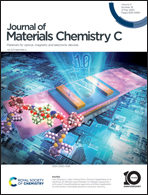Modulation of hyperthermic and relaxometric responses of magnetic iron oxide nanoparticles through ligand exchange provides design criteria for dual-functionality†
Abstract
Magnetic iron oxide nanoparticles (MNPs) are the subject of intense study as theranostic tools that combine magnetic resonance imaging (MRI)-trackability with AC-field responsive heating. In this study, we report MNPs synthesised using a modification of an established thermal decomposition method which, following extensive parameter optimisation, provides strong hyperthermic heating efficacy that is reproducible batch to batch. The suspensions have an exceptional specific absorption rate of ∼2800 W g−1 (intrinsic loss power, ILP ∼20.4 W m2 g−1 kA−2 kHz−1) within a high concentration range (collective particle scenario) falling to ∼1000 W g−1 (∼7.9 W m2 g−1 kA−2 kHz−1) on full dispersion by dilution. The effect of stabilising ligand surface chemistry on the concentration-dependent hyperthermic and MRI efficacies was evaluated by ligand exchange/phase transfer from organic to aqueous and back to organic suspension, and on the formation of organogels. Fast field-cycling NMR relaxometry of the different suspensions reveals the role of moment dynamics and of subtle differences in particle and solvent diffusion in determining both the hyperthermic and relaxometric efficacies. These insights identify particle design compromises that are required to simultaneously optimise MNPs for the two applications.

- This article is part of the themed collection: #MyFirstJMCC


 Please wait while we load your content...
Please wait while we load your content...